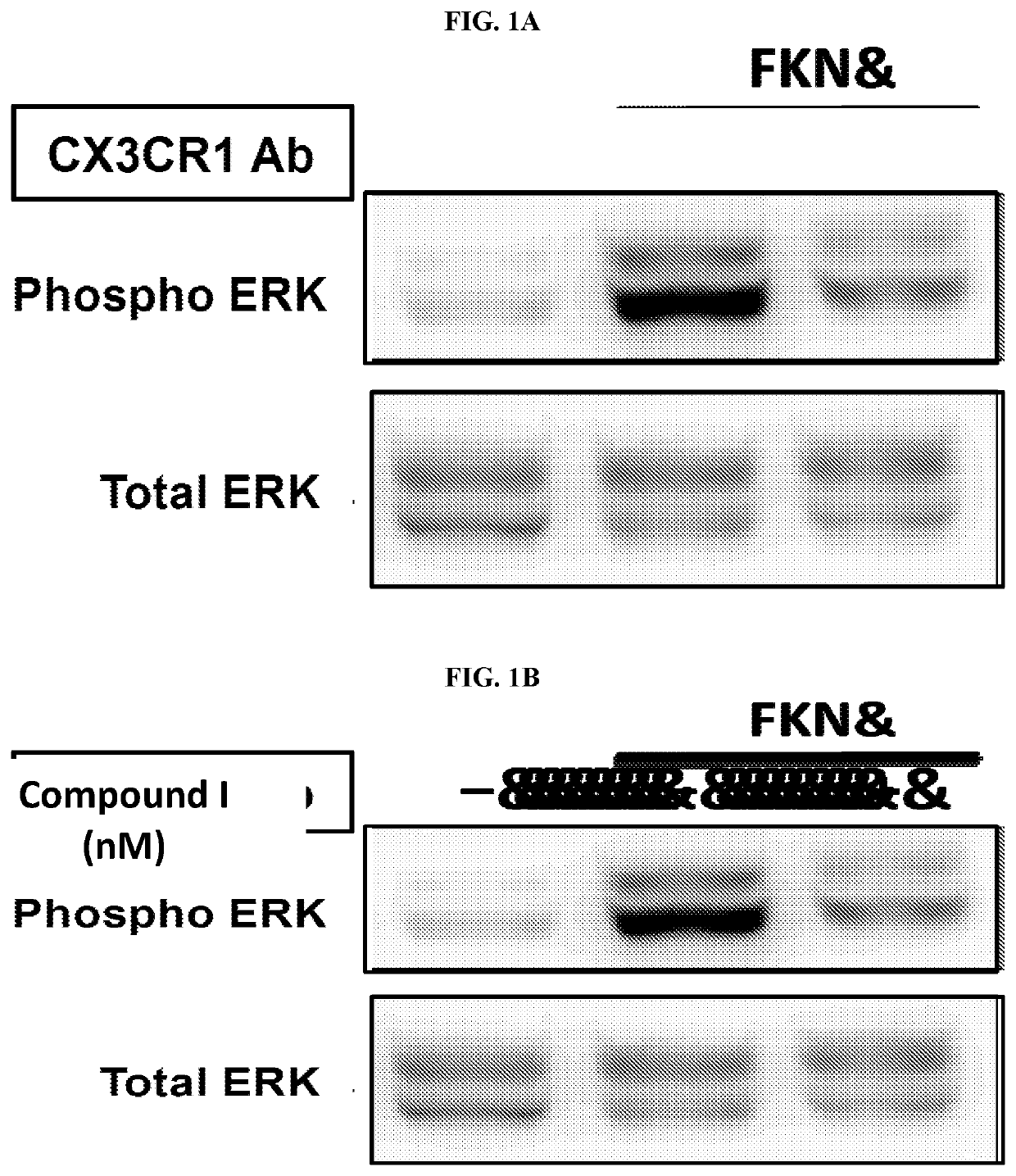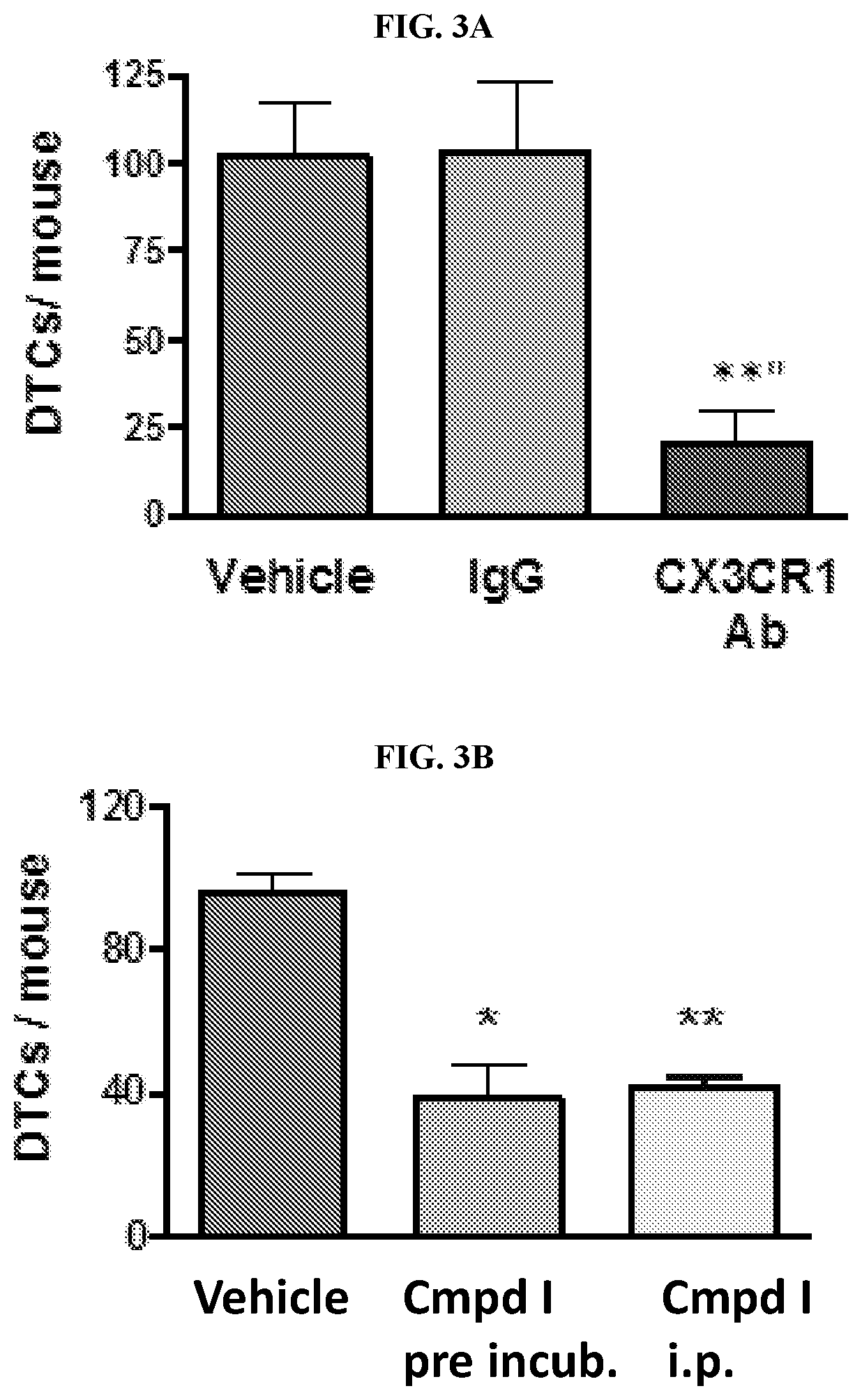CX3CR1 Small Molecule Antagonists, and Methods Using Same
- Summary
- Abstract
- Description
- Claims
- Application Information
AI Technical Summary
Benefits of technology
Problems solved by technology
Method used
Image
Examples
example 1
n of CX3CR1 Signaling In Vitro
[0288]In a first set of experiments, SKBR3 human breast cancer cells were incubated with 15 μg / ml of a neutralizing antibody for CX3CR1 (TP-502, Torrey Pines Biolabs) or to different concentrations of Compound I (5-(3-(4-(4-chlorophenyl)piperidin-1-yl)propyl)pyrrolo[1,2-a]quinoxalin-4(5H)-one) for 30 minutes at 37° C. prior to be exposed to human recombinant Fractalkine (50 nM) for 5 minutes.
[0289]At the end of the experiment, total cell lysates were obtained using a single detergent lysis buffer containing DTT, phosphatase inhibitor cocktail (Calbiochem), protease inhibitor cocktail (Calbiochem) and Igepal CA-630 (Sigma-Aldrich). Protein concentrations of cellular lysates were determined using a BCA protein assay (Pierce). Samples containing equivalent amounts of protein were resolved by SDS-PAGE using 10% polyacrylamide gels and then transferred onto Immobilon PVDF membranes (Millipore Corporation). Membranes were blocked for one hour at room temperat...
example 2
f CX3CR1 Inhibition Measured In Vivo
Effects of CX3CR1 Inhibition of Tumor Seeding.
[0291]When cancer cells spread from a primary tumor or an existing metastatic tumor to other sites, they re-enter the blood circulation thus becoming Circulating Tumor Cells (CTCs) and upon seeding in a tissue they convert into Disseminated Tumot Cells (DTCs). For the pre-clinical experiments evaluating how CX3CR1 inhibition would affect the number of DTCs in the skeleton, CX3CR1 was targeted with three different approaches: a) A neutralizing antibody pre-incubated with human breast cancer cells prior to their grafting into experimental animals; b) genetic silencing of CX3CR1 based on CRISPRi technology using a deactivated Cas9; c) administration of Compound I via the intraperitoneal route before and after the grafting of human cancer cells.
[0292]For the experiment, MDA-231 human breast cancer cells were genetically engineered to stably express Green Fluorescent Protein (GFP) by transduction with a pro...
example 3
of Compound I Analogue Precursors
[0303]A solution of compound 1 (1 eq) and compound 2 (1 eq) in acetic acid were stirred under microwave at 200° C. After 5 minutes, the mixture was diluted with EtOAc, washed with brine, dried over Na2SO4 and concentrated. The residue was purified by flash chromatography on silica gel (petroleum ether / EtOAc=20:1) to give compound 3 as a colorless oil (96% yield).
[0304]To a solution of 3 in MeOH was added 10% NaOHaq at 50° C. After 3 hours, the reaction was monitored by TLC analysis. Concentrated HCl was added to this mixture then diluted with EtOAc, washed with brine, dried over Na2SO4 and concentrated. The residue was purified by flash chromatography on silica gel (AcOEt / petroleum ether=1:3) gave compound 4 as a colorless oil (90% yield).
[0305]A solution of compound 4 (1 eq) and DIPEA (3 eq) in DCM were stirred at RT, DPPA (2eq) was added slowly to this mixture, then heated to 50° C. for 3 h. The reaction was monitored by TLC analysis, then diluted ...
PUM
| Property | Measurement | Unit |
|---|---|---|
| Time | aaaaa | aaaaa |
| Time | aaaaa | aaaaa |
| Time | aaaaa | aaaaa |
Abstract
Description
Claims
Application Information
 Login to View More
Login to View More - R&D
- Intellectual Property
- Life Sciences
- Materials
- Tech Scout
- Unparalleled Data Quality
- Higher Quality Content
- 60% Fewer Hallucinations
Browse by: Latest US Patents, China's latest patents, Technical Efficacy Thesaurus, Application Domain, Technology Topic, Popular Technical Reports.
© 2025 PatSnap. All rights reserved.Legal|Privacy policy|Modern Slavery Act Transparency Statement|Sitemap|About US| Contact US: help@patsnap.com



